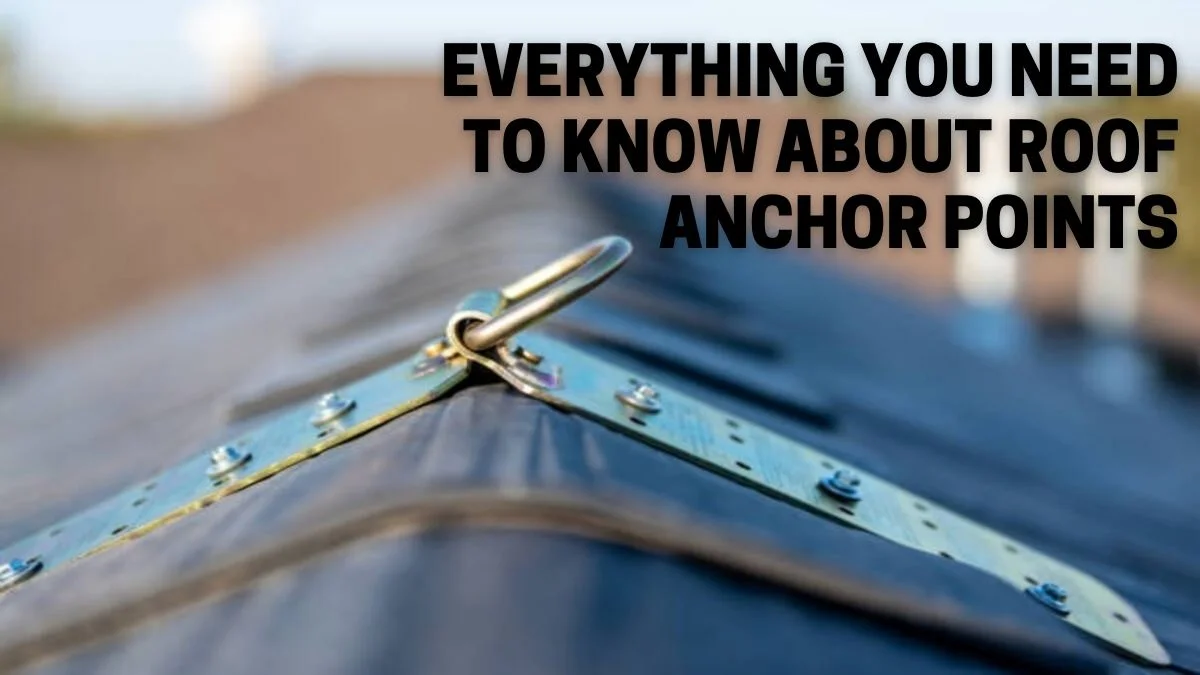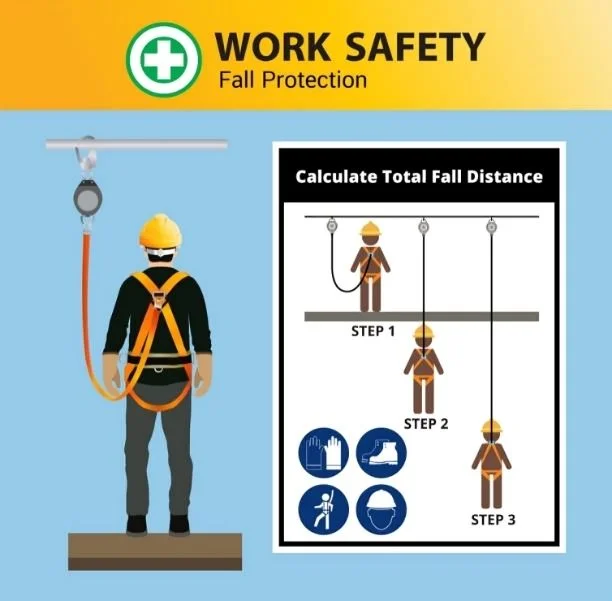TIPS
Everything You Need to Know About Roof Anchor Points

When it comes to working at heights, safety is the number one priority. Whether you’re involved in construction, maintenance, or roof inspections, roof anchor points are crucial in ensuring the protection of workers. These points act as reliable attachment points for fall protection systems, preventing accidents and minimizing the risks associated with high-altitude work.
In this guide, we will delve into what roof anchor points are, why they are essential for height safety, the different types available, how to install them, and much more.
Table of Contents
What Are Roof Anchor Points?
Roof anchor points are secure attachment points installed on roofs to provide a stable and reliable connection for fall arrest systems. These systems, which include safety harnesses and ropes, are vital for preventing falls when working on roofs, facades, or other elevated surfaces. Roof anchor points are integral to fall protection and restraint systems and must be installed according to strict safety standards to ensure effectiveness.

The primary function of these anchor points is to reduce the risk of workers falling from heights during various tasks, including construction, maintenance, window cleaning, and more.
Why Are Roof Anchor Points Important?
Roof anchor points are a critical element in ensuring fall safety and compliance with workplace health and safety regulations. By providing secure attachment points for workers’ safety equipment, these systems help mitigate the dangers of working at heights, reducing the risk of injuries and fatalities.
Here are some reasons why roof anchor points are essential:
- Minimize Fall Risks: Anchor points help reduce the chance of falls, a leading cause of injury in workplaces involving height.
- Compliance: Properly installed anchor points ensure compliance with national and international safety standards, such as AS/NZS 1891.4:2009 and AS/NZS 5532:2013.
- Versatility: Suitable for various applications such as maintenance, inspection, and window cleaning.
- Protection: By keeping workers securely attached, anchor points offer peace of mind for both employers and employees.
Types of Roof Anchor Points
Selecting the right type of roof anchor point depends on the type of building, the materials used, and the specific safety needs of the job. Below are some common types of anchor points:
1. Low Profile Structural Mount Anchor Point
The Low Profile Structural Mount Anchor Point system is designed for safe rope access and fall arrest for personnel conducting maintenance or building services. This type of anchor is used in commercial and infrastructure applications and is ideal for flat or low-sloping roofs.
- Compliance: Meets AS/NZS 1891.4:2009 and AS/NZS 5532:2013.
- Usage: Primarily used for commercial building maintenance, plant, and equipment servicing.
2. Concrete Mount Anchor Point
This anchor point is specifically designed for concrete roofs, providing a secure attachment for fall arrest and rope access systems. It is ideal for maintaining facades, windows, gutters, and roof equipment on concrete structures.
- Compliance: AS/NZS 1891.4:2009 and AS/NZS 5532:2013.
- Application: Used in concrete roofing structures for various maintenance tasks.
3. Concrete Mount Ballast Anchor Point
The Concrete Mount Ballast Anchor Point is built for abseil rope access and fall arrest. This system is designed for use in concrete ballast, membranes, or garden applications and offers secure anchorage for workers involved in facade maintenance and cleaning tasks.
- Compliance: AS/NZS 1891.4:2009 and AS/NZS 5532:2013.
- Application: Ideal for concrete ballast and building maintenance.
4. Top Mount Anchor Point
The Top Mount Anchor Point system is designed for installation on steel roof sheeting. It provides secure attachment points for workers using rope lines, energy absorbers, and harnesses. Proper layout of anchor points is essential to prevent pendulum falls from roof edges.
- Compliance: Meets AS/NZS 1891.4:2009 and AS/NZS 5532:2013.
- Usage: Commonly used on steel roofs for industrial and commercial buildings.
5. Top Mount Abseil Anchor Point
Similar to the Top Mount Anchor Point, the Top Mount Abseil Anchor Point system is used for securing abseil ropes. It is typically installed on steel roofs to provide secure points for workers involved in external building cleaning and maintenance.
- Compliance: AS/NZS 1891.4:2009, AS/NZS 4488.2:1997, and AS/NZS 5532:2013.
- Application: Ideal for facade maintenance and external building cleaning.
How Do Roof Anchor Points Work?
Roof anchor points work by providing a stable and reliable connection point for workers’ safety harnesses or ropes. These systems prevent falls by ensuring that the workers are securely attached to the structure while performing tasks at height.
When a worker falls, the anchor point absorbs the force and holds the worker in place, minimizing the risk of injury. In fall arrest systems, this involves the use of a safety harness, energy absorber, and rope line connected to the anchor point.
Installing Roof Anchor Points
Installing roof anchor points requires specialized knowledge and should be performed by certified professionals. Improper installation can compromise the integrity of the system and pose significant safety risks.
Here are the key factors to consider when installing roof anchor points:
- Structural Integrity: Ensure that the roof or surface can support the forces exerted during a fall.
- Compliance with Standards: The installation must meet all relevant safety regulations, such as AS/NZS 1891.4:2009 and AS/NZS 5532:2013.
- Correct Positioning: The location of anchor points is critical to preventing swing falls and ensuring the system functions properly.
- Expert Installation: Certified installers have the experience and tools to ensure that anchor points are installed securely and effectively.
Maintenance and Inspections of Roof Anchor Points
Regular inspection and maintenance of roof anchorare essential to ensure they remain in proper working condition and comply with safety regulations.
- Frequency: Anchor points should be inspected at least once a year, or more frequently if they are used regularly.
- Visual Checks: Look for signs of wear and tear, corrosion, or any damage to the anchor points.
- Load Testing: Conduct load tests to ensure the anchor points can withstand the required forces.
Who Can Install Roof Anchor Points?
While installing roof anchor points may seem straightforward, it requires specialized training and knowledge to ensure compliance with safety standards. Certified professionals should handle the installation, as improper installation can result in system failure and significant safety hazards.
- Certified Installers: Hire professionals with experience in installing fall protection systems.
- Safety Compliance: Ensure that the installation meets the necessary local and national safety standards.
Choosing the Right Roof Anchor Point
Choosing the appropriate roof anchor point for your building involves several considerations, including the type of roof, the load requirements, and the intended use of the system. Here are some factors to keep in mind:
- Type of Roof: Different roof types, such as metal and concrete, require different anchor solutions.
- Load Requirements: Ensure that the anchor points can support the forces generated during a fall.
- Environmental Conditions: Consider the weather, corrosion risks, and other environmental factors that may affect the longevity of the anchor points.
- Safety Compliance: Ensure the chosen anchor points comply with relevant Australian Standards.
Conclusion
Roof anchor points are an essential component of any roof safety system, offering critical protection for workers at heights. Whether you’re working in construction, maintenance, or any other industry that requires rooftop access, these anchor points are necessary to minimize the risk of falls and ensure compliance with safety regulations.
When selecting, installing, and maintaining anchor points, it is vital to consult with certified professionals and ensure that all installations comply with relevant safety standards. Proper maintenance and regular inspections are also key to ensuring the system remains effective and functional for years to come.
If you’re considering installing roof anchor points on your building, make sure to consult with height safety experts who can provide tailored solutions that meet your specific needs and ensure the highest level of protection for your workers.
frequently asked questions (FAQs)
1. What are roof anchor points, and why are they important?
Roof anchor points are secure attachment points installed on roofs to provide a reliable connection for fall protection systems, such as safety harnesses and ropes. They are essential for ensuring worker safety when performing tasks at height, minimizing the risk of falls, and ensuring compliance with safety standards like AS/NZS 1891.4:2009 and AS/NZS 5532:2013.
2. How do I choose the right roof anchor point for my building?
Selecting the right roof anchor point depends on factors like the type of roof (metal, concrete, etc.), load requirements, environmental conditions, and the specific task (fall arrest, rope access, or restraint). It’s important to consider the roof’s structural strength, accessibility, and compliance with safety regulations before choosing the anchor point system.
3. Can I install roof anchor points myself, or do I need a professional?
Installing roof anchor points requires specialized knowledge and expertise. It is strongly recommended to hire certified professionals who are trained to install anchor points that meet all safety standards. Improper installation can lead to safety hazards and compliance issues, compromising the effectiveness of the system.
4. How often should roof anchor points be inspected and maintained?
Roof anchor points should be inspected at least once a year, or more frequently if they are regularly used. Inspections should check for signs of wear, corrosion, or any damage to the system. Regular maintenance ensures that the anchor points remain functional, safe, and compliant with safety regulations.
5. What standards should roof anchor points comply with?
Roof anchor points must comply with Australian safety standards such as AS/NZS 1891.4:2009 (for selection, use, and maintenance) and AS/NZS 5532:2013 (for manufacturing requirements for single-point anchors). These standards ensure that the anchor points are safe, reliable, and capable of withstanding the required forces during a fall.
-

 GENERAL5 months ago
GENERAL5 months agoChristofle – For Those Who Dream of Family Heirloom Silver
-

 SPORTS7 months ago
SPORTS7 months agoDiscover the World of Football with Streameast: Watch Your Favorite Leagues and Tournaments
-

 GENERAL4 months ago
GENERAL4 months agoUncovering the World of кинокрадко: The Dark Side of Film Piracy
-

 GENERAL2 months ago
GENERAL2 months agoATFBooru: Anime, Gaming, and Subculture Imageboard























